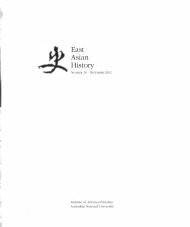Exhibiting Meiji Modernity: Japanese Art at the ... - East Asian History
Exhibiting Meiji Modernity: Japanese Art at the ... - East Asian History
Exhibiting Meiji Modernity: Japanese Art at the ... - East Asian History
- No tags were found...
You also want an ePaper? Increase the reach of your titles
YUMPU automatically turns print PDFs into web optimized ePapers that Google loves.
EXHIBITING MEIJI MODERNITY: JAPANESE<br />
ART AT THE COLUMBIAN EXPOSITION<br />
~ judith Snodgrass<br />
On April 15, 1893, <strong>the</strong> Japan Weekly Mail reported <strong>the</strong> sad f<strong>at</strong>e of one of<br />
<strong>the</strong> more spectacular works of art to be exhibited by Japan <strong>at</strong> <strong>the</strong> World's<br />
Columbian Exposition in Chicago th<strong>at</strong> year. It was an imposing enamel<br />
triptych-a censer and two vases-th<strong>at</strong> stood over eight feet high, "<strong>the</strong><br />
most colossal examples of cloisonne enamel ever seen",} made even more<br />
imposing by <strong>the</strong>ir magnificently carved bases of keyaki wood. Suzuki<br />
Sh6emon, <strong>the</strong> leading artist of <strong>the</strong> Nagoya School, had taken four years<br />
to make <strong>the</strong>m, and <strong>the</strong>y had been "specially viewed and approved" by<br />
<strong>the</strong> emperor himself for inclusion in <strong>the</strong> exhibition. 2 Though very highly<br />
regarded among <strong>Japanese</strong>, <strong>the</strong>se exhibits had been rejected from <strong>the</strong> Fine<br />
<strong>Art</strong>s section and releg<strong>at</strong>ed to <strong>the</strong> Hall of Manufactures. The reason, according<br />
to <strong>the</strong> Japan Weekly Mail, was <strong>the</strong> political allegory of <strong>the</strong>ir design,<br />
which, as we will see, was a st<strong>at</strong>ement of Japan as leader of Asia and protector<br />
of Korea. "It is hard to wed politics with art", it observed. 3 Perhaps<br />
so, but <strong>the</strong> aim of this paper is to show just wh<strong>at</strong> a determined <strong>at</strong>tempt<br />
<strong>the</strong> organisers of <strong>the</strong> <strong>Japanese</strong> exhibition made to put art in <strong>the</strong> service of<br />
politiCS <strong>at</strong> <strong>the</strong> Columbian Exposition.<br />
The Mail might also have mentioned, for example, th<strong>at</strong> <strong>the</strong> contentious<br />
design had been conceived by Shioda Shin ti.EB~, <strong>the</strong> Special Counsellor<br />
for <strong>Art</strong>s of <strong>the</strong> Imperial Commission to <strong>the</strong> Exposition,4 and th<strong>at</strong> <strong>the</strong><br />
1 "<strong>Japanese</strong> Enamel Exhibits <strong>at</strong> Chicago,"<br />
Japan Weekly Mail, 15 April 1893. Though<br />
<strong>the</strong>re is no name on <strong>the</strong> article, it is probably<br />
safe to assume th<strong>at</strong> it was written by<br />
<strong>the</strong> founder and editor of <strong>the</strong> Mail, Frank<br />
Brinkley, a collector and connoisseur of<br />
<strong>Japanese</strong> art. This article was one of series of<br />
linform<strong>at</strong>ive pieces on <strong>the</strong> various c<strong>at</strong>egories<br />
of art exhibited. Brinkley's essays were<br />
published in F. Brinkley, Japan: Its <strong>History</strong>,<br />
<strong>Art</strong>s, and Liter<strong>at</strong>ure, (Boston: J B Millet Co,<br />
1901-2). See Ellen Conant, "Captain Frank<br />
Brinkley Resurrected," in Treasures oj<br />
Imperial Japan, vo!.l, Selected Essays [<strong>Meiji</strong><br />
Ino takara: Ronbun hen] TbeNasserD. Khalili<br />
Collection oj <strong>Japanese</strong> Decor<strong>at</strong>ive Ali, ed.<br />
Oliver Impey and Malcolm Fairley (London:<br />
The Kibo Found<strong>at</strong>ion, 1995), pp.l24-5, for<br />
<strong>the</strong> most recent assessment of Brinkley's<br />
career as publisher, and more impoI1antly,<br />
his previously overlooked expertise as collector<br />
of quality art in <strong>Meiji</strong> Japan.<br />
2 Japan Weekly Mail, 15 April 1893, p.453.<br />
3 Ibid.<br />
4 From Halsey C. Ives, ed., World's Columbian<br />
EXPOSition, Official Public<strong>at</strong>ion, Revised<br />
C<strong>at</strong>alogue, Department oj Fine <strong>Art</strong>s with<br />
Index oJExhibitions (Chicago: W.B. Gonkey,<br />
1893) quoted in Treasures oJlmperialjapan,<br />
vol.], Enamels [<strong>Meiji</strong> no takara: Shipp6]<br />
Nasser D. Khalili Collection oj <strong>Japanese</strong> <strong>Art</strong>,<br />
ed. Oliver Impey, Malcolm Fairley and Jack<br />
Hillier (London: The Kibo Found<strong>at</strong>ion, 1995),<br />
p.74. It continues:<br />
Their manufacture was undertaken by<br />
Mr Shirozayemon Suzuki, of Yokohama,<br />
with <strong>the</strong> co-oper<strong>at</strong>ion of Mr Seizayemon<br />
Tsunekawa, <strong>at</strong> Nagoya. The original design<br />
was painted by Mr Kanpo Araki, ofTokyo,<br />
and <strong>the</strong> black ink sketch on <strong>the</strong> copper<br />
was made by Kiosai Oda, of Nagoya.<br />
The men directly in charge of making <strong>the</strong><br />
vases were Gisaburo Tsukamoto and Kihio<br />
ye Hayashi of Toshima ... . The bronze<br />
American eagle was made by Yukimune<br />
Sugiura, of Tokyo.<br />
75
















